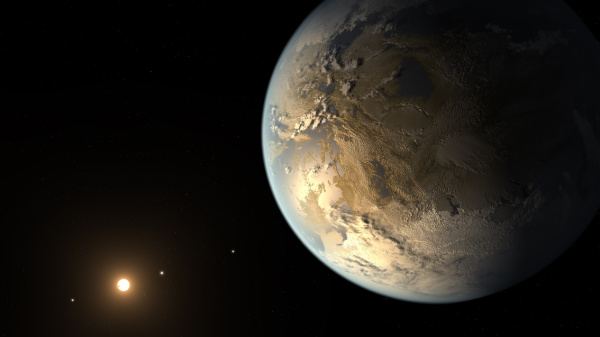Question
Gramps,
Answer
John,
In April 2014, astronomers announced the discovery of Kepler-186f, a planet located approximately 500 light-years away in the constellation Cygnus. This planet is particularly noteworthy because it is situated in the habitable zone of its star, meaning it is at the right distance to potentially support liquid water—an essential ingredient for life as we know it. The Kepler space telescope, which operated from 2009 to 2013, played a crucial role in identifying this planet by monitoring the brightness of stars and detecting the slight dimming that occurs when a planet transits in front of its host star.
Kepler-186f is classified as an exoplanet, a term used to describe planets that orbit stars outside our solar system. It is approximately 10% larger than Earth and is believed to be rocky, which further increases its potential for habitability. According to the Extrasolar Planets Encyclopedia, as of now, 1,783 exoplanets have been confirmed, with 350 of them being roughly the size of Earth. The discovery of Kepler-186f is a significant milestone in the search for life beyond our planet, as it represents a tangible example of a potentially habitable world.
The implications of finding Earth-like planets extend far beyond mere scientific curiosity. The existence of Kepler-186f suggests that there may be billions of other planets in our galaxy that could also support life. A study conducted by astronomers at the Universities of California-Berkeley and Hawaii indicates that the Milky Way may contain tens of billions of Earth-sized, possibly habitable planets. This staggering number raises profound questions about our place in the universe and the nature of life itself.
The search for extraterrestrial life has been a topic of interest for scientists and theologians alike. Many scientists argue that the discovery of life on other planets would challenge traditional religious beliefs, particularly those that center around the uniqueness of Earth and humanity. However, for members of The Church of Jesus Christ of Latter-day Saints, the existence of life beyond Earth is not only plausible but is also supported by scripture.
Latter-day Saint teachings provide a unique perspective on the existence of life beyond Earth. In the Pearl of Great Price, the ancient prophets Moses, Enoch, and Abraham recount their encounters with God, who reveals the vastness of His creations. Moses is told, “Worlds without number have I created” (Moses 1:33), suggesting that the universe is filled with countless inhabited worlds. This belief aligns with the scientific findings regarding the potential for life on other planets, including Kepler-186f.
The Church’s cosmological views emphasize that God is not limited to our planet or even our solar system. The existence of other worlds inhabited by sentient beings is not only possible but is also a reflection of God’s infinite creative power. As the prophet Enoch states, “Were it possible to number the particles of the earth, yea, millions of earths like this, it would not be a beginning to the number of Thy creations” (Moses 7:30). This perspective encourages members of the Church to embrace scientific discoveries that suggest the existence of life beyond Earth, viewing them as complementary to their faith rather than contradictory.
The intersection of science and theology is a rich area of exploration, particularly when it comes to the question of extraterrestrial life. The discovery of Kepler-186f serves as a bridge between these two realms, prompting discussions about the implications of life beyond our planet. While some may view the search for extraterrestrial life as a challenge to religious beliefs, members of The Church of Jesus Christ of Latter-day Saints see it as an affirmation of their faith.
The Church’s teachings suggest that God’s creations are not confined to Earth, and the existence of other worlds inhabited by intelligent beings is a possibility that aligns with their understanding of the divine. This belief is echoed in the writings of Church leaders, who have expressed that the vastness of the universe is a testament to God’s greatness. As one Church leader noted, “No reasonable person will, I think, doubt that the tendency of modern research has been in favor of the supposition that there may be life on some of the other globes.”
Science plays a crucial role in expanding our understanding of the universe and our place within it. The discovery of Kepler-186f and other exoplanets challenges us to reconsider our assumptions about life and the cosmos. It invites us to explore the possibility that we are not alone in the universe and that God’s creations extend far beyond what we can see.
The Church encourages its members to engage with scientific inquiry and to seek knowledge about the universe. This pursuit of knowledge is not seen as a threat to faith but as a means of deepening one’s understanding of God’s creations. As Latter-day Saints explore the implications of discoveries like Kepler-186f, they are reminded of the words of the prophet Joseph Smith, who taught that “space is infinite” and that “there are no outside curtains to it.” This perspective fosters a sense of wonder and curiosity about the universe, encouraging believers to seek answers to the profound questions that arise from scientific discoveries.
Gramps







